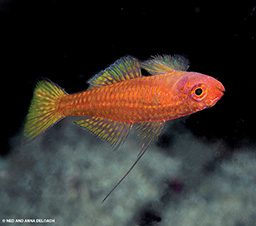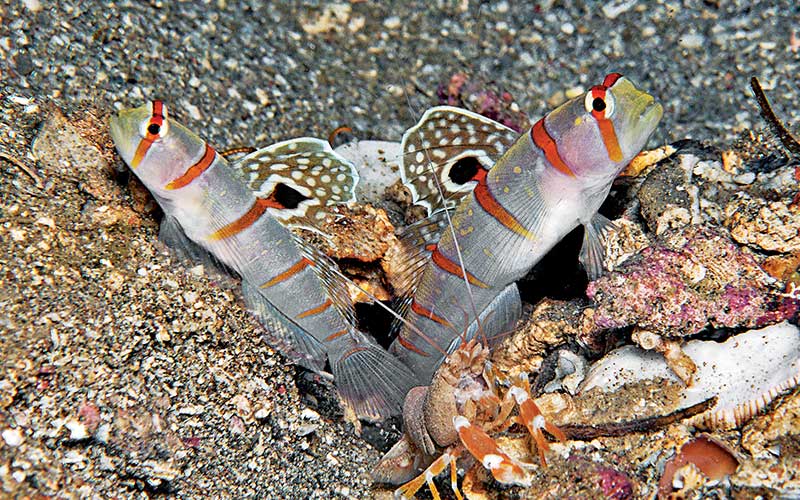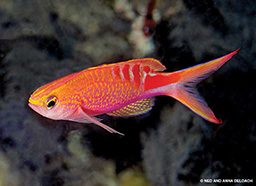t just doesn’t seem right to leave a classic world of coral and fish to stick your head inside a hole, but that’s exactly what I did for a week this spring in Fiji. The dive trip with a group of friends was my last chance to take species photos for a new edition of Reef Fish Identification: Tropical Pacific, and I was determined to make the most of it.

We spent much of our week soaring around underwater spires, known locally as bommies, that towered above the Fijian seafloor like skyscrapers. Their tangled coral tops, bathed in year-round sunshine and warm currents, are a refuge for an ocean full of reef fishes seeking sanctuary from long-jawed predators that circle like fighter jets out in the blue. Exploring a booming bommie top on a clear sunny day is as good as diving gets. But many of the species I’m after live secretive lives inside crevices and caves honeycombing the peaks’ plunging slopes. Caves tend to hide special things, and in this case it’s a seldom-seen menagerie of fishes just waiting to be appreciated.
On the first morning, our skiff drops six of us in the lee of a sun-spun ridge buzzing with life. Without a second glance my buddy and I head straight down the cliff face, losing light with every kick. We slip beneath an overhang at 90 feet and finger-walk into darkness. Like a thief in the night I cast my narrow beam into a bewitching Tinkerbell world of encrusting sponges, corkscrewing gorgonians and delicate fingers of coral that drip from the ceiling like pink chandeliers. The fish that live here are few and far between and don’t care at all to be seen. It takes 10 minutes before my beam finds a rarely observed deepwater cave bass. I freeze, and for three memorable blinks the fish freezes in my light before vanishing back into the shadows.

Fish become more prevalent as we work our way up toward the surface. At 50 feet ambient light from above reflects off the sand floors, making it easier to spot movement in the dimness, and I need all the help I can get. I’m after Trimmas, half-inch gobies that are nearly invisible until they dart from perches to nab passing specks of zooplankton. Other members of the genus hover near the walls like squadrons of miniature drones. Like much of the marine life inhabiting caves, the little Trimmas are not well studied. Many remain undescribed, patiently awaiting scientific classification and formal Latin names.

The next day a pair of Randall’s shrimpgobies stops me in my tracks at 50 feet. These big-finned, cave-dwelling beauties are not unfamiliar — I’ve encountered dozens over the years — but I will still happily dedicate an entire dive to another sighting, especially one of a matching pair. Shrimpgobies are skittish in the extreme. It takes most of my bottom time to sneak a close look without sending the pair bolting back into their sand burrow, which is maintained by a perpetually bulldozing partner shrimp.
The hunt picks up pace when I join forces with Cat Holloway, a longtime friend and former cruise director of our liveaboard. Over breakfast she traces her finger down my wish list of fish names until she stops with a knowing tap on Lori’s anthias. “I remember where we used to find these guys,” she chirps. “They’re deep, and there aren’t many about. I’ll pop down tomorrow and have a look.”
Powered by a pair of full-foot fins, Cat comes sailing up from below, motioning for me to follow her down to a soft-coral ridge half hidden behind a swirling cloud of anthias. Signaling for me to wait, Cat shines her light into one opening and then another until she relocates the cluster of a half dozen pink and yellow Lori’s anthias packed as far back into the pocket as they can get.

Our next quest is for an elusive, straw-thin waif of a fish discovered by Cat and later scientifically described by my co-author, Gerry Allen, Ph.D. Today the pipefish bears the name of our liveaboard — it’s known as the Naia pipefish (Dunckerocampus naia). The honor is commemorated with a piece of stained glass depicting the namesake, which hangs in the ship’s salon. “You’re simply not leaving Fiji without a photo of our fish,” Cat proclaims. It becomes her mission to see that I don’t.
We are anchored near the site where the species was discovered in 2004, and Cat spends her first dive bouncing from cave to cave without luck. On the next two dives she recruits volunteers from the other skiff to join in the hunt, but in the end it’s Cat who finds a pair of the pipefish gliding through the shadows where the ledge tapers into a riddle of dark holes — a near-perfect hideout for a fish that doesn’t care to be seen.
© Alert Diver — Q3 Summer 2015